18th November 2022
Part One: Reinterpretation
Alice asked us as a class to work together in pairs and come up with a sentence as to What does Re-interpretation Mean?
Noah and I had a chat about the term and what we thought it meant and came up with the following.
Produce an original piece of work based on a concept or idea from somewhere else. It could be changing the material, changing the type if work (sculpture, painting, photo, etc) And changing the meaning of the original work in the new context.
Alice told us that the definition of Re-interpret is Interpret Again
On our own, we had a few minutes to come up with synonyms for Re-interpretation, I thought initially that this should be straightforward as I’m ok with words and language but as soon as took the lid off my pen, my brain dried up.
Eventually I got a few out: Re-reading, re-imagining, revisit, further understand, relearn, realise, clarify, re-translate, review, parody, satirise and appropriation.
I’m aware that the last few aren’t really synonyms for the original word but Alice asked us to think of more situations..
When we went around the room other classmates came up with: reanalyse, redefine, re-evaluate, rethink, re-educate, re-examine, redevelop.
Alice read out a good solid list of others too.
Rethink, redefine, readdress, re-examine, reimagine, retrace, replan, rearrange, re-evaluate, modify, reframe, change, transform, revamp, revolutionise, rework, reconsider, revisit.
There were some good words in these three selections and words I kept hearing coming up throughout the lesson were, reimagining, transform and realise.
We then looked at artists who use Re-interpretation in their practice.
Gillian Wearing.

Alice asked us to read the image and I wrote down some notes. Around the fact that the photographer may have had a low self esteem and idolised her glamorous sister. Makeup, hair and clothes looked like a fashion shoot for a magazine cover, Vogue, Cosmo etc.
The mouth was slightly open and not smiling, the eyes engaged with the camera/viewer, quite suggestive and showing confidence.
I thought it looked as though the image had been shot in a studio due to the plain background, single catchlight in the eye, as a self portrait obviously due to the title.
I then considered that it might be a memorial of her dead sister (if she was dead) and could also have been a school photo reimagining as her “dead” sister died before she got to the age of school photos like a yearbook picture.
Alice enlightened us as to the reason the image was made and how it was made. She pointed out that there was a giveaway in the area around the eye, but on the projector it was tricky to spot.
Concealed
Wearing had been wearing a mask of her sister’s face as part of a series called Album where she recreated the photos from a family album using the skills of Madame Tussauds to create prosthetics and masks to assist. She was quoted as saying she “seized her sisters identity” in this image based upon an 80s photo of her sister. I’m not sure what that means, whether she hijacked her sisters identity or stole it from her.
Only Wearing’s eyes and teeth are visible through the mask, everything else is a carefully considered, researched and designed element of the photo.
Wearing’s photo Self Portrait as my brother Richard Wearing (2003) shows her in a prosthetic body suit posing as her brother in his bedroom back in the 80s. It is considered a transformation of identity and the words reconstructing, transforming, recreated were used here.
We were then shown Self Portrait at three years old (2004) in which she played herself as a young child and the face of her younger self looks out at the viewer quite convincingly until you notice the eyes are not those of a three year old. That’s when it becomes “Uncanny” as though trying to be super real but almost being nearly perfect with just a little edge to give it a creepy feel to it.
John Stezaker
another artist who uses reinterpretation in his work, using found images to overlay and collage to produce other images.
We were given 5 mins to look at a picture Old Mask I (2006) and make some observations.
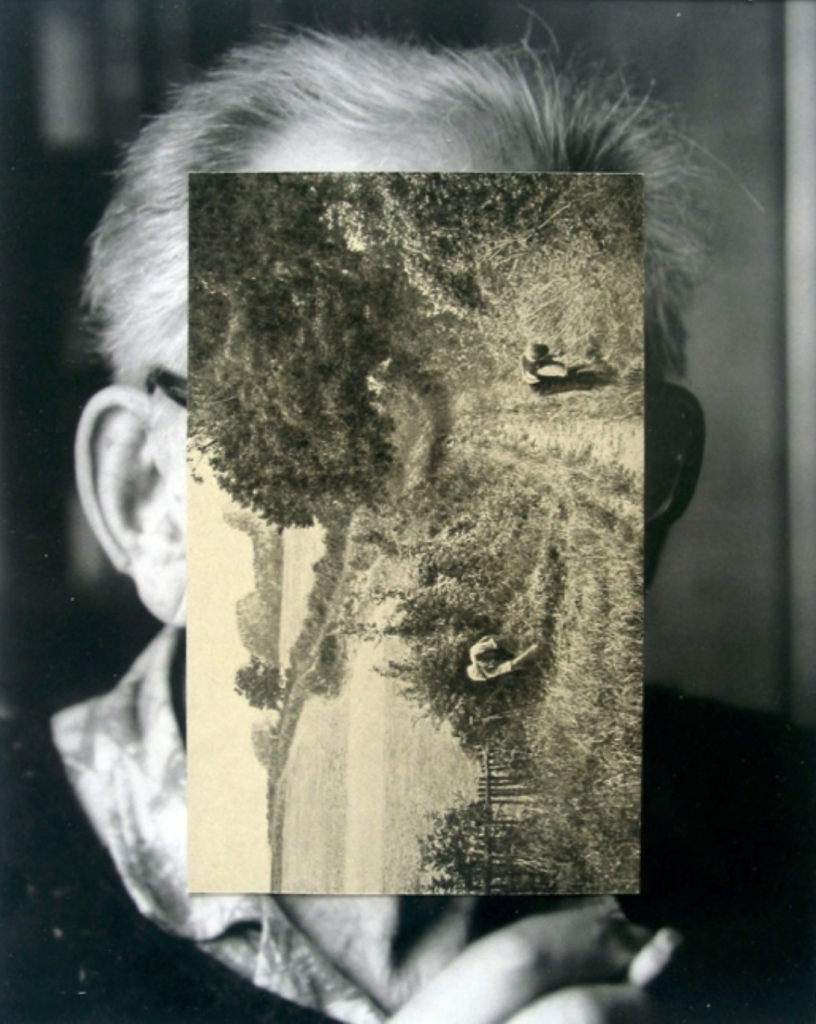
It’s a mixture of two images, one is a black and white image with a sepia toned rural image on top of it. The underneath image appears to be an author’s biography photo from a book of an old man smoking a cigarette, whilst the image on the top is of an old rural pastoral scene showing workers harvesting grass or hay from the side of a tract in a very leafy scene.
I thought that the tree overhang in the lane lined up with the glasses of the old man underneath and the lines of the hedgerows coming down the image aligned with the veins/tendons in the old man’s neck. It might be that Stezaker is trying intimate that the old man was once a country mouse and is now a townie, cigarette and all.
He is trying to get us to question the photographs as truthful or not, and whether or not it is a real memory captured in the image.
We were then shown Pair IV (2007) from Stezaker which shows a man and woman from a seemingly still image from a movie, with a postcard on top of their faces.
The cliff faces become the characters faces, the lines of the rocks align to the facial features and there appears to be a gulf of open space between the two of the subjects. I read it as an impasse, a canyon that they’ll not connect over.
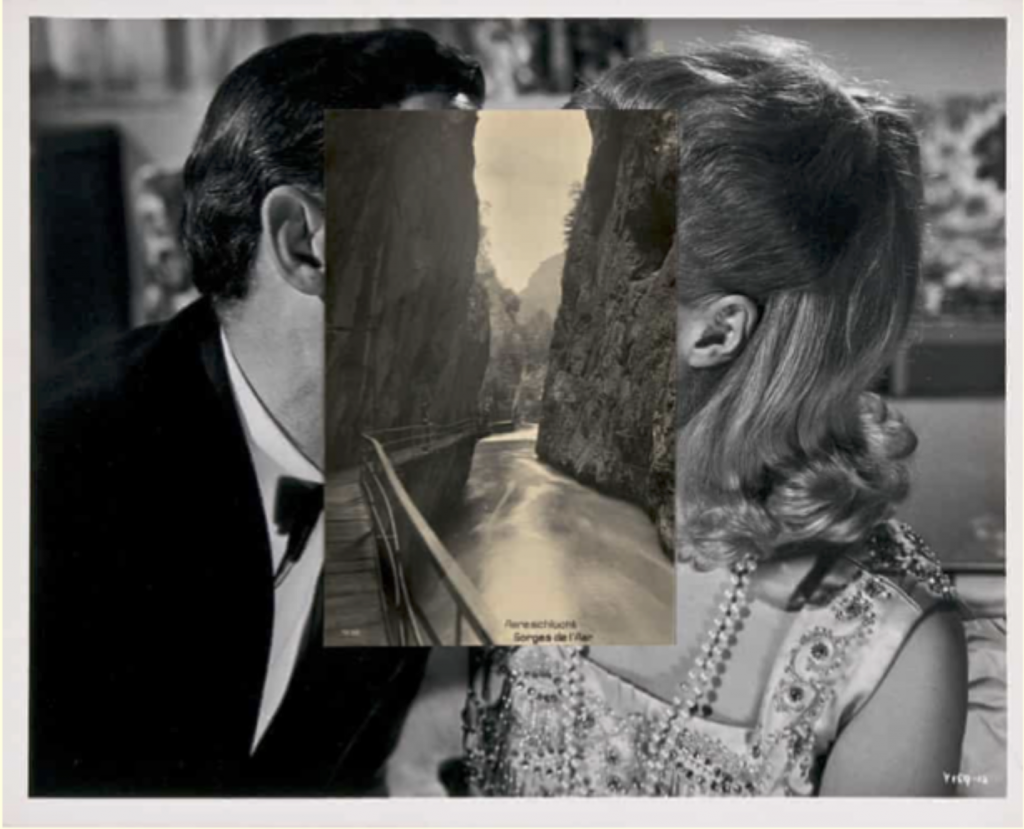
Alice then shared a video about Stezaker’s work, from Curator’s Insights on YouTube.
Catherine Opie
Another artist shared with us this morning was Catherine Opie and we were shown Jo (1993) and asked to read the photograph. Alice did let slip that the colours were important but I missed them and was way off the mark with where she was going. My notes on the image consisted of me noticing the Green backgrounds was like a green screen so the subject could be transported to anywhere. The Yellow hair was reminiscent of the Marilyn portrait of Andy Warhol. The subject was androgynous and difficult to tell if it is a female/male/other. I thought it was a female and from the detail around the midriff I thought it was a coded or hidden message that this person may have been pregnant too.
I thought it looked like the pose of Audrey Hepburn in Breakfast at Tiffany’s and the tattoos and jewellery appeared to make this person a rocker/biker or punk style of person.
Alice then talked about the image and told us that Opie was tired of not seeing her community represented in the media or arts so took it upon herself to reimagine some classic Renaissance paintings using a rich textured background and vibrant colours, base don the work of Hans Holbein. She had initially been inspired by Lewis Hine’s work on child labour, to take up photography and we watched a video on the YouTube website of a TATE

The image Dyke (1993) was then shown to us with a textured backdrop and then also a comparison of Self Portrait/Cutting (1993) and Christina Of Denmark, Duchess Of Milan (1538) by Hans Holbein Jr. and the backdrops are a similar rich colour and patterned material. The portraits are said to be Royal and Opie calls them her Royal Family pictures. She’s really used the renaissance style of image to speak about the community that she’s engaged with to show them in a manner that they normally wouldn’t be shown in. Photos of this subject might normally have been stereotypical but with this homage to the renaissance and fine art portraits she has expanded the audience and changed the meaning of the picture to be a celebration of who is in the image, rather than just a person of a particular gender/sexuality etc.. The cutting in the back is real and shows that she is willing to suffer for her art and also to suffer for equality of the sexes and a stop to prejudice around the “nuclear” family.
Tom Hunter
was next up with his photograph, Woman Reading Possession Order (1997) which plays on the form of Vermeer’s Girl reading a letter at an open window (1657). It’ an obvious staging of an image to resemble the original but the context has been altered from a wealthy house to a squat and the letter replaced by a document telling the squatter she’s about to be moved out of the house she’s bringing up her child in.
The light on the face of the woman and the baby shows a sign of hope even in the depressing scene that is shown. The image is very painterly to my eyes and in the accompanying video that we watched it was stated very clearly just how precise Hunter was with his directions to the subject, about how she should stand, how she should have her head tilted etc, it shows an attention to detail that impresses me greatly. It reminds me somewhat of the image of Sir Joshua Henry I set up in my first year whereby I had to recreate or reinterpret an existing painting. The setting up and getting similar lighting was a challenge and I salute the effort that went into Hunter’s photo.
Thomas Kellner
A photographer whose work uses some of the influence of Cubism and he makes images that deconstruct and reinterpret architectural landmarks. Hi image of San Francisco, Afternoon at Golden Gate Bridge, 2004 uses individual frames on a film camera into a contact sheet made up of a huge number of negatives to provide something similar to an Instagram story containing 9 images that fit together to make a single image when scrolled through. This San Francisco image is nearly a metre wide and tall. Kellner states his cubism interest came from his art history classes and it can be seen in the multiple angle/perspectives of his work on single subjects. Some of his images made up of multiple negatives and contact sheets are more structured , whereas some of the others go a little more haywire providing some strange angles and odd looking features on the buildings and structures that he’s photographing.
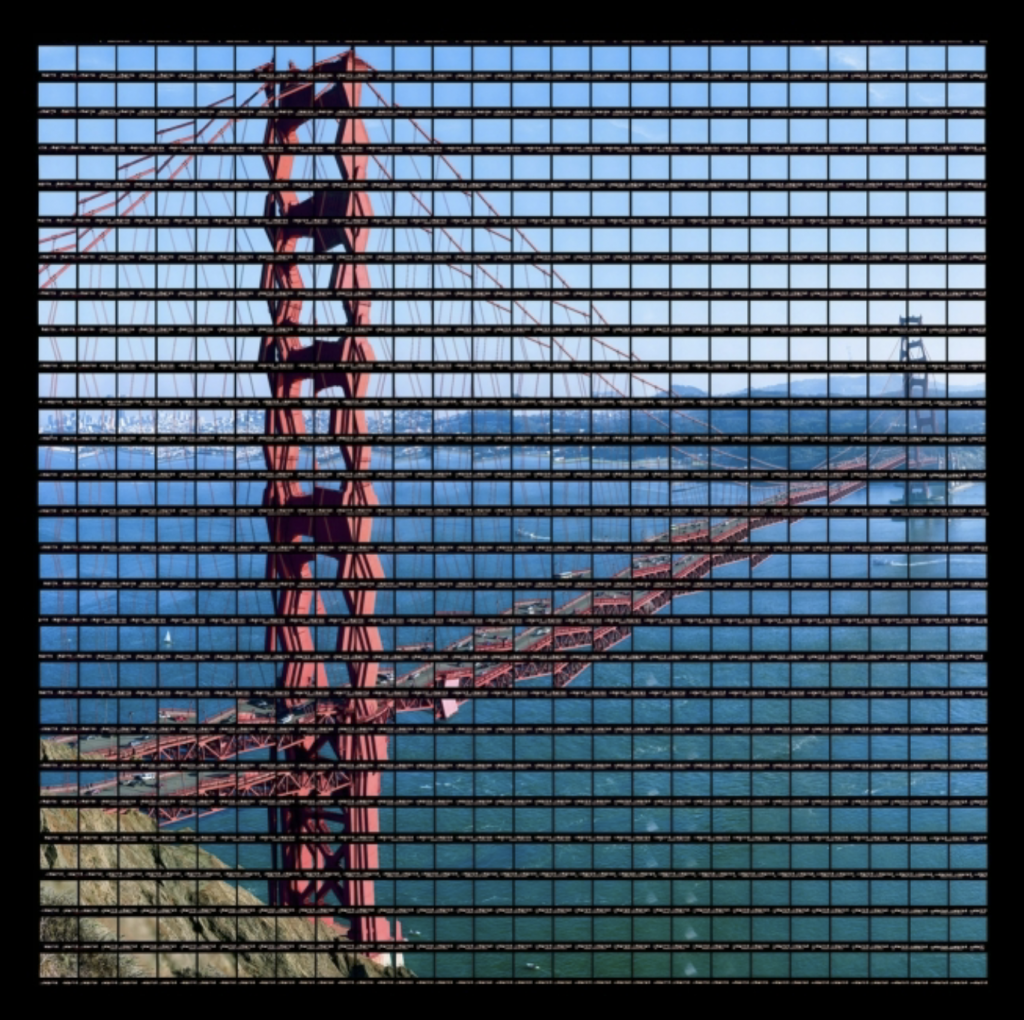
35,83″ x 35,43″
England, Lacock Abbey, 2002 is a good example of this.. There is a good deal of similarity between this work and David Hockney‘s photomontages that have a similar appearance but differing methods to get the end result.

I will look further into this work and other similar artists for my work with deconstruction in my Full Year Project as it has a similar feeling for me and I think it might be helpful to see other artists viewpoints on how and why they do these type of works.
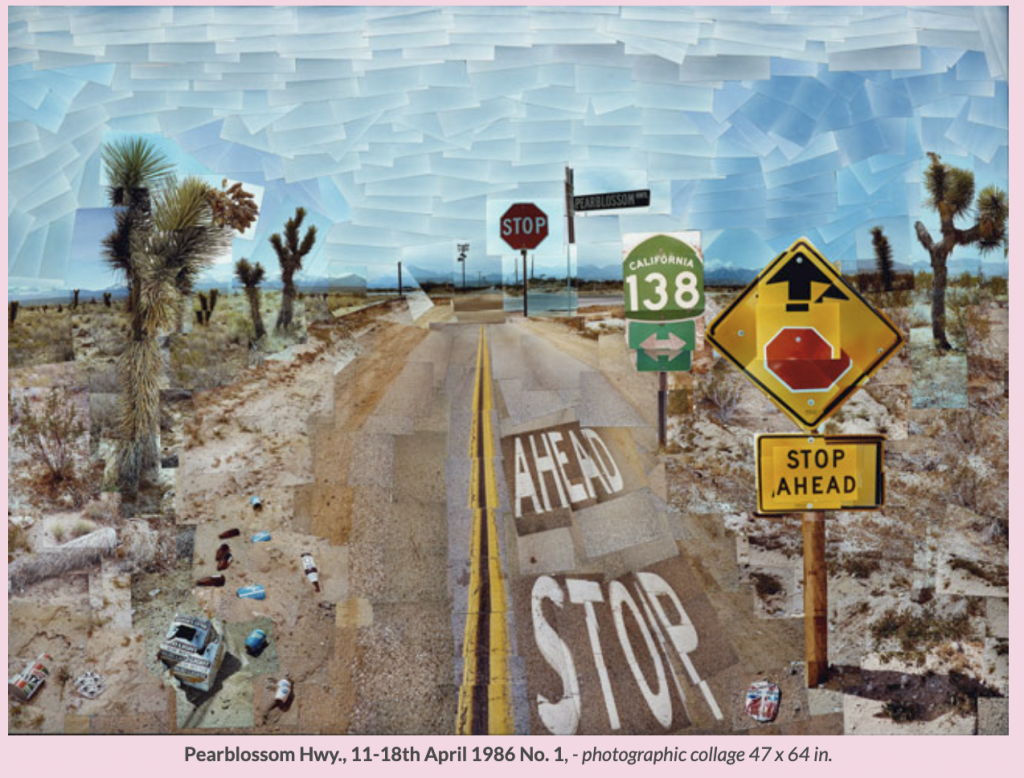
Lorna Simpson
We then talked about Lorna Simpson who photographed a series called 9 Props (1995) in which she took items from the photos taken by James Van Der Zee in the 20s, 30s and 80s, had them made into a physical object and then photographed it simply with an additional description of the original photograph that the vase or bowl had been sighted in originally.
It asks questions of the viewer as to what the images represent but it is a clever device to use. She was also able to use this as a Modernist style artwork to remove the label of political art that had been used around her work up to this point.
It’s also interesting to see some of Van Der Zee’s work which had been altered to include images of dogs and other items to make the subject look a part of a different class or wealth status, but today look really fake and like a poor piece of clip art. It’s odd that this man’s work features photos showing such truths and then these with obvious fakery involved in a non-ironic way.
Re-Interpretation Task
To copy the last slide of Alice’s pack, it shows us the challenges ahead with respect to Re-interpretation.
Your challenge
- Re-interpret a key photograph from your independent research…
- Who have you looked at so far? What stands out? Something you admire? Something you wish to critique? Something outdated?
- How can you re-interpret the photograph to create new meaning?
- Identify another artist who reinterprets as part of your independent research
The response to this task will appear in another post. Link will follow.
Part Two: Reflection Models
The Reflective Process
Alice asked us to think about what Reflecting might mean to us. For me it’s a process of looking at what has been, learning from the result and then putting into place strategies to improve the outcome next time.
Alice said it’s “Checking Your Awareness” meaning that if we are filling our books with work that constantly fails and we’re not learning lessons and correcting then we need to think more about the processes and how we go through the methods.
It is about assessing our own performance and using critical thinking and the feedback from others to improve our practices and processes.
Alice shared with us the notion of the Reflective Cycle of Dr Graham Gibbs from his Learning By Doing book in 1988. I’ll come to it in a moment in diagram form but we were asked why it’s important to reflect on our own work and performance. It’s apparent that if you keep doing the same thing over and over without changes then it will never improve and we heard of the term Meaningful Reflection. This term means that you’ve thought about the outcome and worked out why something worked well or not so well before being able to pick out a way to improve. Rather than the surface reflection of “I don’t like this ” we can investigate it more meaningfully ‘I do not like this because it’s reminiscent of another piece of work by this artist and is too derivative or my process failed due to the temperature of the developer as it had just been mixed.”
Work Experience
In my workplace we are taught to discover the “Root Cause” by using such tools as 5 Whys and Ishikawa diagrams, and whilst I often do not draw these or make notes on them, as part of having it ingrained in my thinking I tend to do it instinctively. Once we find the Root Cause we create Corrective Actions and this improves the performance of the next iteration of the operation.
Learning To Overcome Setbacks
The group was asked to think about a time when we were learning a new skill and encountered setbacks. What strategies did we use to overcome the setbacks?
I wrote in my book that Unicycling is my skill, learned through adversity and setbacks. To overcome each setback or obstruction I used goals and then persevered until I reached the goals, even if they were small goals. Once I’d achieved the goal I celebrated it. First step was to sit on it without falling off, then move my feet back and forth, then riding along whilst holding a wall, then to get one pedal cycle away from holding on, then 5, then 10 and then to the end of the garden, then to the end of the road, then around the block etc..
Some of my experiences of these times are captured in videos on my YouTube channel https://www.youtube.com/@admin
Gibbs’ Reflective Cycle
Alice then showed us the Cycle as described by Gibbs. It’s fairly straightforward to think about due to my indoctrination with Total Quality, Six Sigma, Margin Enhancement and LEAN in my work. The only real difference between Gibb’s Reflection Cycle and strategies I’ve used at work is the addition of the “Feelings” step. We would normally consider that as part of the Evaluation step but I can see how it is very important in artistic practice. If feelings are of a certain type it might affect the effort placed into the work, or even the mood of the work. Ideally to replicate the practices and outcomes we should be in the same headspace for the process. That is unless we wish to utilise those different emotions in the work. For me I used Feelings in my preparation for 10m target air rifle shooting (similar to the Olympic sport) in which I made notes of the clothes I was wearing, the mood I was in, whether I’d eaten or had been busy at work on the day. It’s a good practice to keep up with I guess and I do document these types of information in my reflective journal entries..
We didn’t watch it due to lack of available time but a YouTube video called What is Critical Reflection? Was shared so that we can look at it outside the classroom. Here is another linked video: Gibbs’ Reflective Cycle Explained
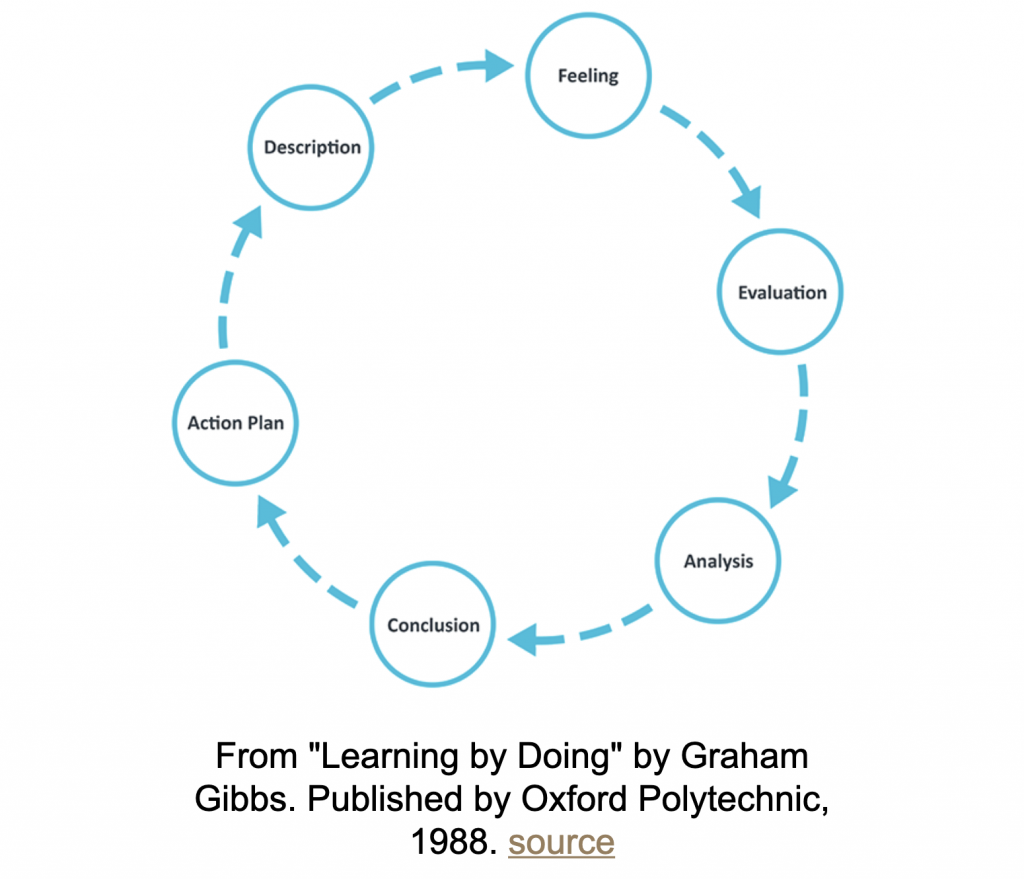
We were shown a link to another video about the What? So What? Now What? Model by Rolfe et al (2001) of reflection too.
We also briefly discussed Schon’s model of Reflection In-action and Reflection on-action whereby some work is done during the process (in-action) to understand what is happening and why the results are like they are, then the (On-Action) Reflection is done after the event so you can look back on it from outside of the work zone.
Evaluation
We talked about the difference between reflection and evaluation. Evaluation is something that is done after the finish of the process so that we can then assess what has happened and look at how it went.
It is often helpful to set a milestone to perform an evaluation to ensure that the wider view aligns with the goals of the project.
Reflection is an ongoing process that should be undertaken on anything that is done, whether it’s research, shooting, developing, adjusting images, results of reviews etc.
We were then given a task to go through our Sketchbooks and add a post it note where we thought that it might benefit from some further additions to the reflection to make it more meaningful.
Task Assignment
Another task we were asked to try and complete outside of the classroom was to use Gibbs Reflective Cycle to write about 250 words on an experience/workshop/lesson at university.
For my selection I chose the extra task of finding a Studium and Punctum for the Camera Lucida seminar.
Description: Find a punctum, a picture that pricks, bruises or wounds me, using the definition by Roland Barthes in his book Camera Lucida. I hoped to find one impactful image in my catalogue. It was a fruitful search that found a photograph of Ewan, 2019.
Feelings: Initially sceptical about whether a photograph might be able to elicit a reaction, until I saw Alice physically moved by her shared punctum. My artiness isn’t as developed as some people so I doubted my ability to find an image that meant a lot to me.
Evaluation: I searched for a while through pictures of my ill parents but none impacted me as much as this image of my son. I found that the image worked for me on the level of a punctum and that it allowed me to write honestly about the contents of the image.
Analysis: I was able to get some good information out of this experience due to my personal connection with the subject, I consider myself responsible for his health and whilst I am usually empathetic I also don’t get emotional about subjects that I have no control over. The picture was able to elicit a response as I was open minded enough to try the exercise, had I not been so, I wouldn’t have found the image.
Conclusions: I may have been able to get on with this quicker had I been less sceptical and cynical. Lack of engagement meant that I thought it wouldn’t work rather than just being open minded from the very beginning and getting on with finding an image that would affect me.
Action Planning: I would definitely be more open minded to some of the work that we’re asked to do. Sometimes I think of myself as a technical person who doesn’t need to know about the artiness of the topic but it definitely helps me with my thought processes and to understand the emotions. The next task will have a more open minded Bob at the start.
Conclusion
Reinterpretation is a commonly used tool to create new original work. It’s important that the new piece is original and produces a piece of work different in context and meaning to the original or uses the original style/piece of work to reinforce the same point.
Some reinterpretation of the images in photography can be as simple as recreating them (not simple I know) or using them as Kellner and Hockney do to create something larger from the parts.
Reflection is an important part of learning, this I know from my training in my job that I’ve held for 33 years. It’s been drummed into us over the years about circular processes with feedback loops to provide input for Continuous Improvement and assessing the parts of the issue separately and without prejudice or bias to figure out what the root cause is.
The reflective cycles we were shown will be useful as prompts to do this more formally in the work we produce, wither in the reflective journal (this blog), sketchbooks or even my body of work.
It’s important as it stops us making the same mistakes time and time again and can help us hone in on the parts of the issues that cause variations and stamp them out.
What started off as a heavy sounding lecture today actually gave me some solid leads in terms of artists to look at with regard to my Full Year Project which is about image deconstruction at the moment.. It also helps to remember to think about why we do things and change them if it’s not working.
[…] In terms of reflecting on this piece of research I will refer to Gibbs’ Reflective Model we studied in Week 8 […]